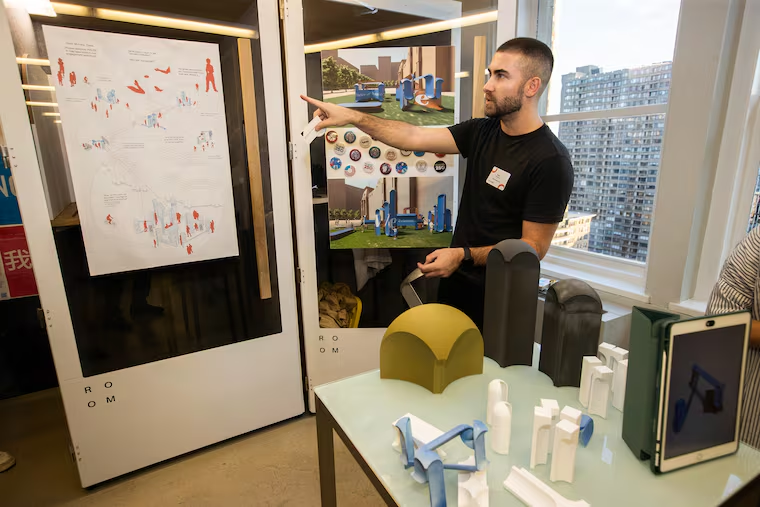A ‘Declaration Station’ could pop up in your neighborhood to mark America’s 250th birthday. Here’s what it may look like.
Three teams presented proposals on pop-up projects to be launched across the city during anniversary of the signing of the Declaration of Independence.

Philadelphia250, a nonprofit that will host programs to mark the country’s 250th birthday, revealed the latest phase of its work at an event on Tuesday.
To a crowd of about 70 people, Philadelphia250′s leaders shared preliminary designs for a mobile station that will engage people across Philadelphia in 2026 in commemoration of the anniversary of the signing of the Declaration of Independence.
“The Declaration Station” is envisioned as a traveling pop-up that will entice people from around Philadelphia to take an active role in honoring America’s monumental birthday. The station aims to prompt residents to respond to questions and participate in conversations about the ideas of the Declaration of Independence and their meaning today.
“We want to center people. We want to go to where they are,” said Jane Grabias, director of programs at Philadelphia250. “Not everyone’s going to come downtown to City Hall or to Independence Mall. We want to go where people are and talk about things that matter to them.”
Earlier this year, Philadelphia250 put out a public call for interdisciplinary design teams to submit proposals. Requirements included being able to move around the city easily, being welcoming and accessible, and having the ability to collect and/or reflect people’s responses to prompts and activities. Three multidisciplinary teams were chosen and each received $10,000 to build the proposals.
On Tuesday, the teams laid out plans for how their stations will look, and how they will engage with residents in conversation around the ideas of the Declaration of Independence.
“We’re really trying to take out what was good about the declaration, that spirit, and think about what it means today. We all know that it was a fraught history, and it wasn’t equal,” said Grabias, acknowledging that previous anniversary commemorations of the Declaration of Independence have excluded women and people of color.
Custom-designed buttons
Architects, designers, artists, and others from Moto Designshop, Holzman Iron Studio, Crafted Action, RustFab, and Ann T. Dinh collaborated on a project focused on buttons. They hope students will design buttons in school and take their creations to metal structures placed throughout the city. The design of the structures is inspired by the calligraphy of the Declaration of Independence. Students will be able to affix their pins to the structures, leaving them for others to see, or grabbing someone else’s, creating an exchange of ideas throughout the city.
A stoop for every ward
Another team includes planners, architects, designers, and fabricators, from an architecture studio, ISA, a non-profit organization, Tiny WPA, and community based artists Chenlin Cai, Calo Rosa, and Serena Saunders. The group aims to bring a stoop to all 66 wards in the city to serve as a place for conversation amongst neighbors. People can also leave their own marks on the stoops by decorating them.
In addition, the team will bring a toolkit of modular structures to each neighborhood that can be turned into objects to fill immediate community needs, such as a bench, a table, or a bookshelf. The goal is for residents and organizers to share skills by building the structures. They also envision all 66 stoops eventually being displayed at Independence Mall.
Your personal declaration
The third team includes designers and architects from PORT, a public design and planning consultancy; Creative Lab III, an architecture studio; and Little Giant Creative, a creative agency. The group hopes to create the atmosphere of a block party, with a large attention-grabbing structure that will travel the city that could include music. A large analog ticker panel — akin to the ones used in old train stations — will display a prompt such as “Philly is_____.”
Residents will be able to share responses on tablets, and sign their own “declaration.” The responses and signatures will then be displayed for others to see on distinct surfaces of the structure.
Looking ahead
The teams will have until December to refine their designs and incorporate feedback from residents and Philadelphia250. In early 2024, an advisory committee will help decide which project will come to life. Ultimately, one of the three design proposals may be selected, or elements from distinct proposals might be combined to build a new concept, says Grabias.
At the end of the project, once the mobile station has roamed the city, Grabias says, it could provide a collective “picture in time” of what Philadelphians are concerned with today, what makes them happy, hopeful, or discouraged. Although there are no formal plans yet for what to do with that gathered knowledge, she says the aim is to be able to reflect the information back to Philadelphians in some way.
The commemoration’s legacy could take various shapes, she says, including “a renewed sense of civic pride, engagement, involvement.”
“We’re trying to have a more hopeful, positive approach and one that we hope, as it amplifies voices, is kind of empowering for people,” said Grabias. “People feel like they don’t have control, nothing will change, their voice doesn’t matter. We want to say that’s not true.”